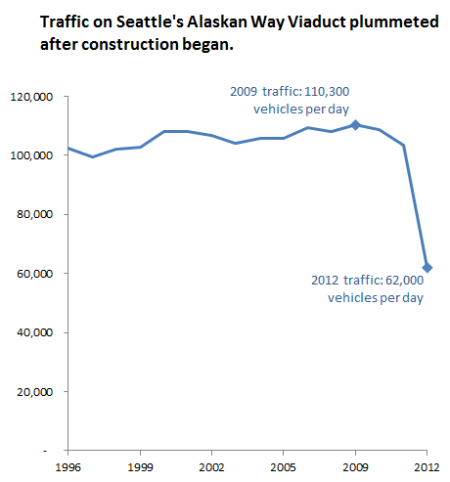Sightline’s Clark Williams-Derry has a terrific post on the astounding decline in traffic on the Alaskan Way Viaduct since Seattle’s Big Dig II began. Trip volumes are down 40% in just 3 years! Clark analyzes the remarkable trend and concludes:
At this point, nobody knows if [tunnel-boring machine] Bertha will ever get moving again, let alone complete her job. But given these figures, maybe it doesn’t matter. Seattle has seamlessly adapted to losing the first 48,000 trips on the Viaduct. No one even noticed. No one even noticed that 40 percent of the Viaduct’s traffic just disappeared! Could accommodating the loss of another 62,000 be that hard if we, I don’t know, tried even a little?

Every day it seems clearer: if we can stop the momentum of expanding-fossil-fuel-infrastructure-as-usual, we can figure out better ways to make energy and better ways to get our butts from point A to point B (and maybe make point A so awesome that our butts will be happier there.)
Of course, none of this is painless or automatic. Car trips on the viaduct are down in part because of long-term investment in transit and increased congestion in spots. Some who don’t have convenient alternatives are facing longer commutes. A planned transition from a freeway on the waterfront to better mobility strategies surely would have been more efficient and effective. But the point is, it’s doable, and much of it is being done essentially by accident.
Even if it causes some inconvenience — big changes always do — we must immediately stop making long-term capital investments that lock us in to chaotic, irreversible climate disruption. This isn’t an “environmental agenda,” it’s a survival imperative, an existential thing, supported by the most exhaustive body of peer-reviewed science in the history of peer-reviewed science. It is what our minds know we must do. It is the Keystone Principle, the reason 398 people were arrested at the White House last Sunday. And for every one of them, 200 more have pledged civil disobedience if necessary.
Mathematically and morally, we simply can’t afford more big, capital-intensive steps backward on climate….especially as it becomes increasingly clear that they’re unnecessary, wasteful, obsolete! This may seem like reading too much into our little tunnel saga, but no single decision looks big in the context of the whole climate challenge. These are exactly the kind of choices that must now be made in the full light of climate consequences.
Is there really any doubt what they should name the mammoth whose tusk was found buried under Downtown Seattle? Whoever writes this stuff is slathering on the irony: we just happened to discover an enormous, perfect fossil of an extinct beast — its spectacular, ostentatious digging tool — buried under downtown Seattle while the tunnel-boring, fossil-fuel-dependence-perpetuating machine ground to a halt nearby.
That mammoth has got to be named Bertha, if only to remind us again that we can still choose a better fate.
Here’s Clark’s amazing-but-true chart:
Thank you Clark and Sightline Daily, for being so gritty and brainy at the same time!


